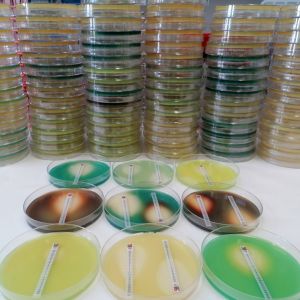El equipo del Centro Nacional de Biotecnología (CNB-CSIC) ha realizado un novedoso abordaje experimental basado en ensayos clásicos de evolución experimental bacteriana. Sara Hernando-Amado, investigadora que ha liderado el proyecto, explica “si bien la mayor parte de los estudios sobre sensibilidad colateral han utilizado cepas modelo de laboratorio (relativamente sensibles a los antibióticos), nosotros planteamos que un requisito imprescindible para la aplicación clínica de la sensibilidad colateral es que se produzca en diferentes mutantes previamente resistentes a otros antibióticos, una situación más próxima a la que encontramos en clínica”. “Por ello, en nuestros ensayos de evolución en presencia de antibióticos, hemos utilizando distintos mutantes de P. aeruginosa previamente resistentes a diferentes antibióticos, buscando patrones evolutivos conservados en todos ellos”. “De esta manera, hemos encontrado que la adquisición de mutaciones de resistencia frente al antibiótico ciprofloxacino da lugar a sensibilidad colateral frente a otros dos antibióticos, tobramicina y aztreonam.” La aparición de este patrón de sensibilidad colateral conservado no es frecuente ni fácil desde el punto de vista genético. En base a esto, los investigadores han determinado que el uso combinado de ciprofloxacino-aztreonam o ciprofloxacino-tobramicina produce la eliminación de los mutantes resistentes de P. aeruginosa analizados.
Hernando-Amado indica que “desde un punto de vista evolutivo, se trata de un caso de convergencia fenotípica (en todos los casos se adquiere la misma sensibilidad colateral) causada por la adquisición de diferentes mutaciones de resistencia frente al antibiótico inicialmente administrado”. Esto implica que “si bien las trayectorias evolutivas que puede seguir este patógeno en presencia de ciprofloxacino son diversas, todas ellas derivan en un aumento de sensibilidad a tobramicina y aztreonam, lo que sugiere una posible aplicación clínica”.
Los ensayos de evolución experimental como los realizados en esta investigación permiten entender la evolución de la resistencia y la sensibilidad colateral a los antibióticos. Este trabajo demuestra que es posible identificar patrones de sensibilidad colateral robustos que permitan el diseño de nuevas estrategias terapéuticas basadas en el uso de antibióticos con los que ya contamos a día de hoy.
Más información
S Hernando-Amado, P Laborda, JR Valverde, JL Martínez. Mutational background influences Pseudomonas aeruginosa ciprofloxacin resistance evolution but preserves collateral sensitivity robustness, Proceedings of the National Academy of Sciences 2022;
DOI: https://doi.org/10.1073/pnas.2109370119
CNB-CSIC Comunicación






